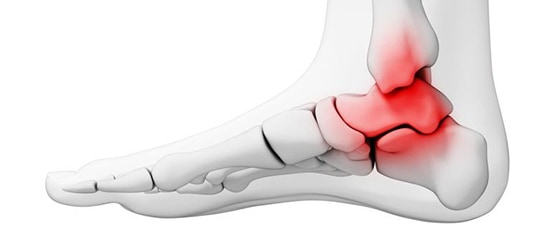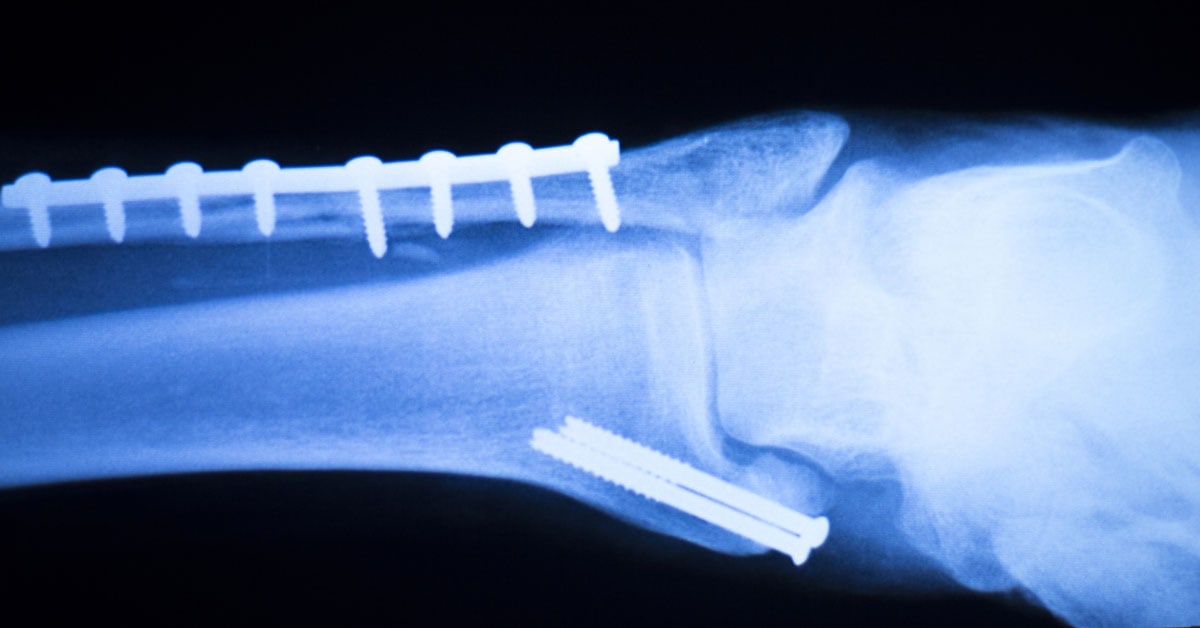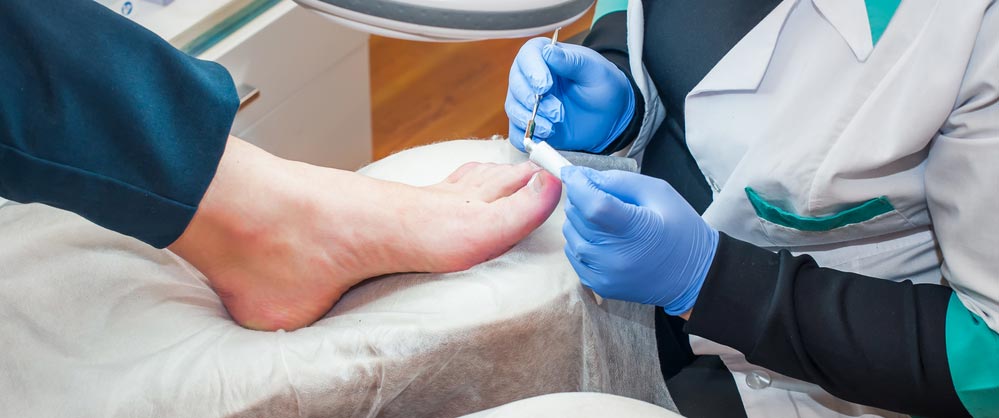- Home
- Foot & Ankle Conditions
- Fractures and Breaks
- Broken Ankle
Broken Ankle: causes, symptoms and treatments
The ankle consists of three bones: tibia (shin bone), fibula, and talus (ankle bone). If any of these bones are fractured, you have a broken ankle. If only the ligaments give way, you have an ankle sprain.
Under-treated ankle fractures are one of the most common orthopedic injuries and have led to an alarming increase in early-onset ankle instability, arthritis, and permanent range of motion issues.
Getting the right diagnosis and medical advice can make all the difference in your outcome. When it comes to your ankle, it’s better to be safe now than sorry later.
- What can cause a broken ankle?
- How is a broken ankle diagnosed?
- What are non-surgical treatments for a broken ankle?
- What are the surgical treatment options for a broken ankle?
- Ankle reconstructive surgery
- Why UFAI is your Best Choice for foot and ankle care
- What are the different types of ankle fractures?
-
Foot and Ankle Surgeon at University Foot and Ankle Institute
Dr. Justin Franson, DPM, is a Board Certified Podiatric Foot and Ankle Specialist and Diplomate of the American Board of Podiatric Surgery. He attended the School College of Podiatric Medicine in Chicago, graduating in 2001. Dr. Franson then accepted a three-year residency program at the Greater Los Angeles VA and UCLA County Hospital.
Dr. Franson specializes in several areas including total ankle replacement and sports medicine. Treating athletes and weekend warriors like himself brings him a lot of joy. Dr. Franson keeps active with running marathons, triathlons, hiking, basketball, and golf.
Read Our Blog Articles About Fractures and Breaks
- Lawn Mowing Causes Lots of Foot Injuries: How to Stay Safe!
- 9 Tips to Help Find the Best Podiatrist for Your Foot Care
- 7 Causes of Inner Ankle Pain Revealed!
- Metal Surgical Screws and Pins May Become Thing of the Past
- 5 Reasons Why You Have Pain on the Outside of Your Foot
- 6 Common Foot Problems that Affect Men and Boys
- Expert Insights On Treatment Options For Cystic Lesions Of The Talus
- Tom Cruise Stunt Mishap Leads to Severely Broken Ankle. He Then Rejects Surgery. Why?
- Sports and Overuse Injuries of the Foot and Ankle
- 5 Signs your Ankle Sprain Might be a Fracture
- There’s nothing you can do for a broken toe...Or is there?
- Dr.'s Most Interesting Cases: the Heel that wouldn't Heal!
- What Your Feet Want You to Know about Playing Tennis
- Toy Scooter Related Injuries: what you need to you know
 Very Professional. Dr. Jafry was extremely communicative.Dale T.
Very Professional. Dr. Jafry was extremely communicative.Dale T. Great experience. Great communication. Great direction for my care. Very happy I chose to go with this particular doctor and o...Christopher R.
Great experience. Great communication. Great direction for my care. Very happy I chose to go with this particular doctor and o...Christopher R. Great service and care. Highly recommend Dr. Franson.David B.
Great service and care. Highly recommend Dr. Franson.David B. If you have to go see a Doctor than this is a great experience.Frank M.
If you have to go see a Doctor than this is a great experience.Frank M. My doctor was great. Really greatRudolph B.
My doctor was great. Really greatRudolph B. Good.David E.
Good.David E. Your Santa Barbara office and Dr. Johnson always give me excellent care!Jayne A.
Your Santa Barbara office and Dr. Johnson always give me excellent care!Jayne A. Dr. Gina Nalbadian was amazing!! I came in with an emergency foot situation and she had wonderful bedside manner and resolved m...Danielle C.
Dr. Gina Nalbadian was amazing!! I came in with an emergency foot situation and she had wonderful bedside manner and resolved m...Danielle C. Don’t go anywhere else for your feet! This is the best place in Santa Monica for kind and caring treatment of your foot issues...Jerri R.
Don’t go anywhere else for your feet! This is the best place in Santa Monica for kind and caring treatment of your foot issues...Jerri R. I was frustrated that after 3 weeks I still hadn’t heard back about my PT referral status. And I did sit in a room for over 30 ...Sarah C.
I was frustrated that after 3 weeks I still hadn’t heard back about my PT referral status. And I did sit in a room for over 30 ...Sarah C. Scheduled my appointment 1 week ahead in Valencia office so I wouldn't be double booked, arrived on time and was kept waiting 2...Shawn B.
Scheduled my appointment 1 week ahead in Valencia office so I wouldn't be double booked, arrived on time and was kept waiting 2...Shawn B. I’m very pleased with Dr. Kelman.Alan S.
I’m very pleased with Dr. Kelman.Alan S.
-
 Listen Now
5 Signs your Ankle Sprain Might be a Fracture
Read More
Listen Now
5 Signs your Ankle Sprain Might be a Fracture
Read More
-
 Listen Now
Expert Insights On Treatment Options For Cystic Lesions Of The Talus
Read More
Listen Now
Expert Insights On Treatment Options For Cystic Lesions Of The Talus
Read More
-
 Listen Now
Lawn Mowing Causes Lots of Foot Injuries: How to Stay Safe!
Read More
Listen Now
Lawn Mowing Causes Lots of Foot Injuries: How to Stay Safe!
Read More
-
 Listen Now
5 Reasons Why You Have Pain on the Outside of Your Foot
Read More
Listen Now
5 Reasons Why You Have Pain on the Outside of Your Foot
Read More
-
 There’s nothing you can do for a broken toe...Or is there?
Read More
There’s nothing you can do for a broken toe...Or is there?
Read More
-
 Listen Now
7 Causes of Inner Ankle Pain Revealed!
Read More
Listen Now
7 Causes of Inner Ankle Pain Revealed!
Read More
-
 Sports and Overuse Injuries of the Foot and Ankle
Read More
Sports and Overuse Injuries of the Foot and Ankle
Read More
-
 Listen Now
Toy Scooter Related Injuries: what you need to you know
Read More
Listen Now
Toy Scooter Related Injuries: what you need to you know
Read More
-
 Tom Cruise Stunt Mishap Leads to Severely Broken Ankle. He Then Rejects Surgery. Why?
Read More
Tom Cruise Stunt Mishap Leads to Severely Broken Ankle. He Then Rejects Surgery. Why?
Read More
-
 Listen Now
Dr.'s Most Interesting Cases: the Heel that wouldn't Heal!
Read More
Listen Now
Dr.'s Most Interesting Cases: the Heel that wouldn't Heal!
Read More
-
 Listen Now
Metal Surgical Screws and Pins May Become Thing of the Past
Read More
Listen Now
Metal Surgical Screws and Pins May Become Thing of the Past
Read More
-
 What Your Feet Want You to Know about Playing Tennis
Read More
What Your Feet Want You to Know about Playing Tennis
Read More
-
 Listen Now
9 Tips to Help Find the Best Podiatrist for Your Foot Care
Read More
Listen Now
9 Tips to Help Find the Best Podiatrist for Your Foot Care
Read More
-
 6 Common Foot Problems that Affect Men and Boys
Read More
6 Common Foot Problems that Affect Men and Boys
Read More














